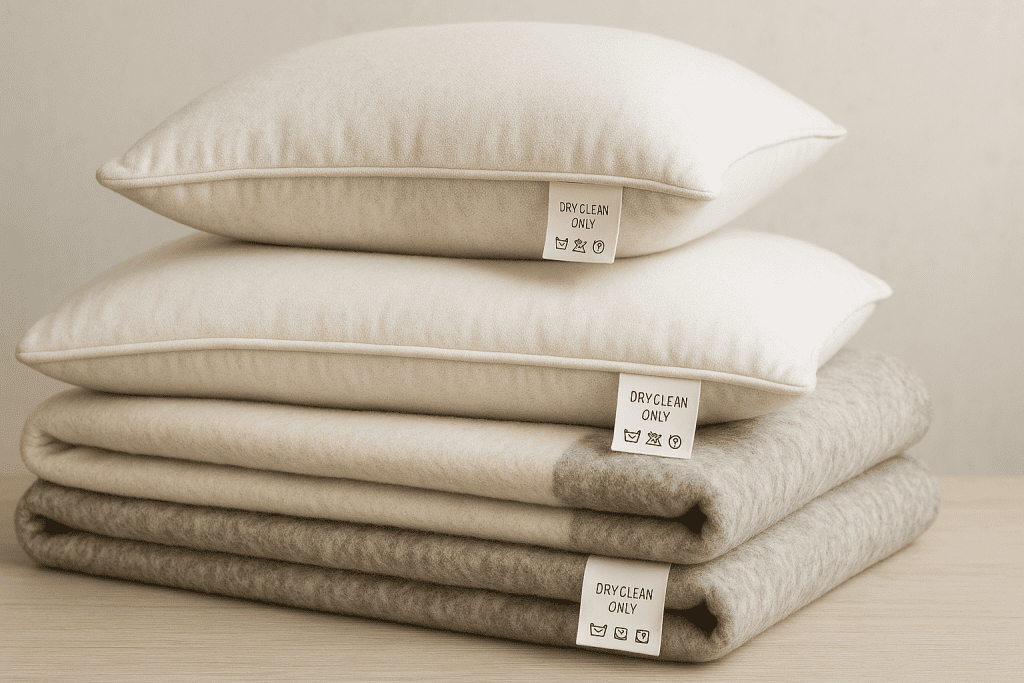
If seasonal sniffles turn into year‑round sneezing, your clothing and home textiles may be part of the problem. Fabrics act like magnets for dust mites, pet dander, and fine particles that irritate the nose, eyes, and skin. For many “dry‑clean‑only” items—think suits, wool coats, silk blouses, drapes, duvets—traditional home laundry isn’t an option. That’s where professional dry cleaning comes in.
At Nettoyeur Marie Claire, our professional process removes embedded soils and allergens safely and effectively, helping you breathe easier at home.
Where allergens hide in your wardrobe and home
Allergens love soft surfaces. Common hot spots include:
-
Outerwear & tailoring: wool coats, suits, blazers, uniform pieces
-
Delicates: silk blouses, cashmere sweaters, scarves, formalwear
-
Home textiles: drapes/curtains, duvets and wool blankets, decorative throw pillows, fabric slipcovers, lightweight area rugs (check care labels)
-
Accessories: hats, shawls, fabric belts and bags
Many of these items can’t be machine‑washed hot without shrinkage, dye bleed, or damage—so allergens accumulate over time unless they’re professionally cleaned.
How professional dry cleaning reduces allergens
Dry cleaning isn’t “dry”—it uses specialized cleaning solutions instead of water. The combination of solvent action, detergents, filtration, and finishing targets both visible soils and microscopic particles that trigger reactions.
1) Solvent immersion dissolves body oils that trap allergens Oils from skin and pets help dust and dander stick to fibers. Professional solvents break down these oils so allergens release from fabric.
2) Professional detergents lift fine particles Dry‑cleaning detergents are formulated to suspend and carry away tiny particles (including dust mite fragments and dander) without rough agitation.
3) Multi‑stage filtration keeps fabrics from re‑deposits Commercial machines filter and refresh the cleaning solution, so removed particles don’t simply move from one garment to another.
4) High‑temperature steam finishing After cleaning, garments and textiles are finished with controlled steam and heat, which helps reduce mites and neutralize lingering residues while restoring shape and drape.
5) Clean handling and protective packaging Post‑cleaning inspection, lint removal, and protective covers help keep items allergen‑free on the way back to your closet.
Bottom line: For fabrics that can’t be washed hot, professional dry cleaning is one of the safest ways to remove dust, dander, and other irritants without damaging delicate fibers.
Dry cleaning vs. at‑home laundry for allergies
-
When to choose home laundry: Sheets, cotton T‑shirts, and other washable items can be laundered regularly. Hot water (per the care label) helps reduce dust mites.
-
When to choose dry cleaning: “Dry‑clean‑only” garments, structured tailoring, and textiles like drapes, wool blankets, duvets, and silk that can’t tolerate hot water or heavy agitation. Dry cleaning removes the oils and particles that standard cold cycles often leave behind.
Items to prioritize if you have allergies
-
Drapes & curtains: Act like giant air filters. Clean every 6–12 months, more often if you have pets or live on a busy street.
-
Duvets & wool blankets: Clean 1–2 times per year; rotate seasonally.
-
Suits, blazers & coats: Clean every 3–6 wears (or at the end of the season) to purge lint, dust, and outside pollutants.
-
**Decorative cushions/throws:** If they’re not machine-washable, dry clean them every three months. You can also do it when they show visible dirt. This helps cut down on dander buildup.
-
Formalwear & delicates: Clean after each wear if exposed to outdoor pollen, pet dander, or fragrance that can irritate sensitive noses.
(Always check the care label. When in doubt, our team can advise on the safest method.)
 Simple habits to keep allergens down between cleanings
Simple habits to keep allergens down between cleanings
-
Change at the door: Swap outdoor clothes for indoor loungewear to avoid tracking pollen and dander inside.
-
Brush off & lint‑roll: A quick lint roll on coats and pants reduces surface allergens.
-
Store smart: Use breathable garment bags for seasonal items to limit dust accumulation.
-
Vacuum regularly: A HEPA‑filter vacuum on carpets and upholstery captures fine particles.
-
Pet care: Keep pets off bedding and brush them outdoors when possible.
-
Reduce fragrances: Fragrance residues can be irritating; choose unscented care when sensitive.
Health note: If you have allergies or asthma, talk to your healthcare provider.
Inquire about a full home plan. This plan should cover:
Mattress and pillow encasements
Air filters
A cleaning schedule
Fabric care instructions
Make sure to get all the details!
Why choose Nettoyeur Marie Claire
-
Fabric-safe expertise: We clean and finish delicate fibers like wool, silk, cashmere, and blends. This process prevents shrinkage and distortion.
-
Thorough inspection: Stain pre‑treatment, pocket checks, and lint removal before careful finishing.
-
Home textiles care: From drapery to duvets and seasonal blankets, we help refresh the textiles that impact your indoor air most.
-
Convenient service: Fast turnaround and friendly advice on care labels and cleaning frequency.
Ready to make your wardrobe and home feel fresher? Contact Nettoyeur Marie Claire to schedule garment or home‑textile cleaning today.
Check out our Facebook!
Frequently Asked Questions
Does dry cleaning remove allergens like dust mites and pet dander? Yes. The process removes and carries away tiny particles, like dust mite bits and pet dander. Steam finishing adds heat, which helps reduce allergens on fabric surfaces. It does this without damaging “dry-clean-only” items.
Is dry cleaning better than washing for allergies? For washable cottons, hot‑water laundry is effective. For delicate or structured items that can’t be washed hot, dry cleaning is the safer and more effective way to remove oils and embedded particles.
How often should I dry clean drapes? Every 6–12 months, or more often in high‑traffic, high‑dust, or pet‑friendly homes.
Will dry cleaning remove pet odors from clothing and blankets? It helps significantly by dissolving the body oils that hold odor and dander. Let us know about persistent odors so we can apply targeted pre‑treatments.
I’m sensitive to fragrances—can you accommodate that? Absolutely. Ask for low‑odor, fragrance‑free finishing and we’ll package items to minimize scent transfer.
 Simple habits to keep allergens down between cleanings
Simple habits to keep allergens down between cleanings